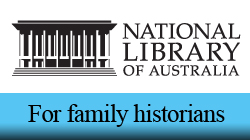Keeping on God’s Right Side: Religion and German Queenslanders
Even though many of the German immigrants to Australia came from a culture steeped in superstition, formalised religion has played a critical role in the history and cultural identity of the German settlers in Queensland.
Unlike the Silesian migration to South Australia a number of religious denominations are represented in the history of Queensland German pioneers and their descendants. Lutherans, Catholics, German Baptists and the Apostolic Church of Queensland were, and continue to be to this very day, the major religious denominations to which the settlers attached themselves. Separate articles are provided on each of these religious denominations, with particular reference to German-Queensland settlement.
Many people consider that the German diaspora in Australia was virtually an exclusive Lutheran religious ethnic migration, however in Queensland the story is much more complex and interesting.
Certainly the large Lutheran communities predominate in terms of geographic extent throughout southern Queensland but in specific regions the other religions were very evident amongst the German communities.
Even within the overall Lutheran communities there were religious divisions – based on both doctrinal and historical affiliations. For instance in the Headington Hill, Nobby, Greenwood, Kumbia and Toowoomba areas of southern Queensland saw an influx of western Victorian German farming families in the early decades of the 1900s who brought with them their own particular ‘brand’ of Lutheranism – the Evangelical Lutheran Church of Australia (ELCA). Many of their Pastors were brought from Victoria. In the 1960s the ELCA merged with the predominant Lutheran branch in rural Queensland – the United Evangelical Lutheran Church of Australia (UELCA). Family names such as Ampt, Huf, Kowald, Pietsch, Mirtschin, Noske, Winter and Noack have had joint religious and migration connections between Victoria and these areas of the Darling Downs.
Many German families were members of the Catholic faith. In southern areas of Australia, particularly in the urban capitals and in vineyard regions (e.g. The Hunter Valley, Tenterfield) large groups of Catholic Germans were settled. In southern Queensland there were many German families of the Catholic faith in the Laidley, Pittsworth and Toowoomba districts. Family names such as Manthey, Schick, Wiemers, Hohn and many families of German-Polish origins have had long associations with the Catholic religion.
The German Baptist denomination has had a long history of church ministry to German communities in the Kalbar, Harrisville, Minden, Tent Hill and Fernvale districts of the Fassifern and Lockyer valleys. Pastor Hermann Windolf, the German Baptist Minister of Kalbar (Englesburg) was also a noted poet and philosopher (see resources section).
Perhaps the religion with the largest regional impact in many isolated parts of Southern Queensland has been the Apostolic Church of Queensland. The history of the Apostolic Church is a fascinating one and for further information a comprehensive article is provided on this website.
When you drive along the busy Warrego Highway linking Brisbane and Toowoomba, at about the ‘half way point’ you’ll pass through Hatton Vale, home of the Apostolic Church of Queensland and its magnificent Cathedral and park-like surrounds – just a stones throw off the busy thoroughfare. In the adjoining cemetery stands an imposing grave, the last resting place of Apostle Heinrich (‘H.F.’) Niemeyer who was the official founder of the Apostolic Church of Queensland. At the entrance to the nearby Cathedral stands an imposing statue of old ‘HF’ – with long-tailed frock coat, handlebar moustache and beard and holding the open Heilige Schrift (Holy Writings). Arriving from Germany in 1883 with his young family he endured many privations and in the early years carved his farm from the ‘Rosewood Scrub’. In later years as he ‘spread the word’ the Apostolic Church of Queensland gained many adherents from the farming communities of Hatton Vale, Brightview, Ropeley, Mt Tarampa and further afield at Mt Beppo. In 1910 to 1912 three separate ships brought adherents of the faith from the industrial Ruhr Valley area and these people were settled, on small farms, at Baffle Creek, Binjour Plateau, Riverleigh and Tansey (near Goomeri).
The congregations expressed themselves strongly through music – choirs, brass bands and zither-based string bands. These musical traditions still carry on today and many of the old German tunes are still fondly remembered and rendered with full vigour.


I would be interested if you have any comment or research on the German immigrants and the Churches of Christ which were established in Rosewood, Mount Walker and Rosevale.